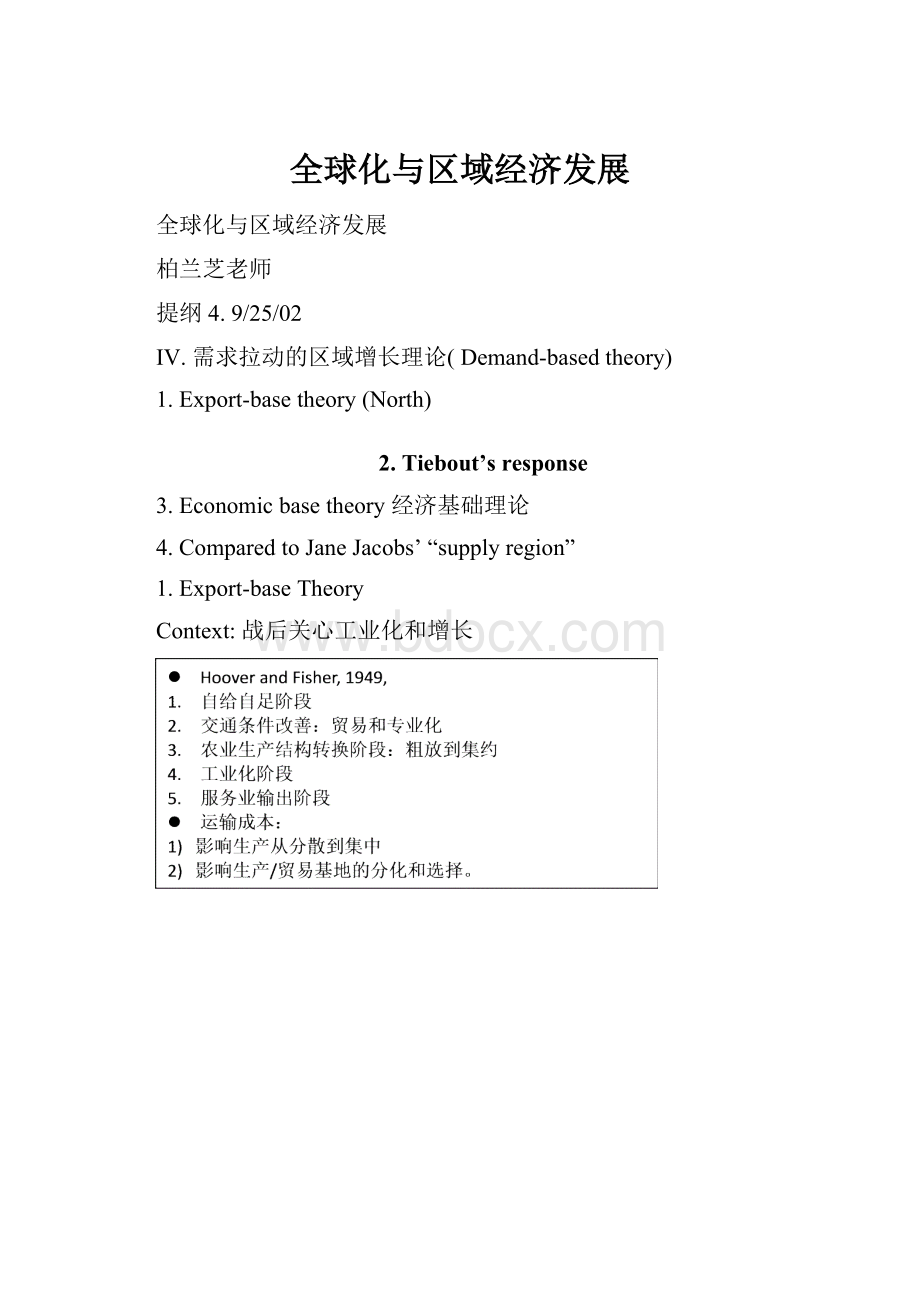全球化与区域经济发展Word文档格式.docx
《全球化与区域经济发展Word文档格式.docx》由会员分享,可在线阅读,更多相关《全球化与区域经济发展Word文档格式.docx(16页珍藏版)》请在冰豆网上搜索。

IntheUS,manyregionsstatedfrom1or2exportablecommodities,
And,exportbaseoftenwidenedaftertransportcostshasbeenreduced
--bringincomebacktotheregion
--developdiversity
--developresidentiaryindustry
--externaleconomy
--technologicaldevelopment
--capital:
investinexistingexportindustry
reinforceexistingexportbase,createunevenregionaldevelopment
4)增长的机制
增长一定要工业化?
ThecaseofOregon:
农业带动的出口也能带动增长
5)So,aregionisdefinedbyitsdevelopmentaroundacommonexportbase.
Thismakesiteconomicallyunifiedandtiestheregion’sfortunestogether.
6)Whatwillinfluencethedeclineofaregion?
Transportation/Technology/Government
2.Tiebout’sresponse:
1956
1)exportbase对小区域比对大区域有用—decidedbythescaleofaregion.
--Howtodefinearegion?
--Notbyexportbase.
--Sizematters.Thelargeraregionis,themoreithasinternaltrade.
E.g.exportonlyaccountsforaverysmallportionofUSeconomy
2)short-termv.s.long-run
othersourcesofregionalgrowth(ofincomeandemployment):
businessinvestment,governmentspending,residentialconstruction,non-economicmigration
3)factorendowment:
E.g.NewJersey’scoal—有煤不见得就有出口,还要看成本
4)stagetheorycounts—E.g.Americaasacolony
5)exportbaseisbettertobeappliedtosatellitecitiesinthesuburbanfringe
6)aregionmustdivideitsenergiesbetweenresidentiaryandexportactivities
●North:
Reply
1)longrun
2)aregion’ssignificanceliesinitsbeingaspecializedpartofthewhole
so,exportbaseisusefultodefinearegion
*长江三角洲,珠江三角洲是区域吗?
有exportbase可用来定义吗?
3)residentiary的发展仍需外力,即出口。
(是吗?
)
●Tiebout再回应
1)强调otherendogenousvariables
2)强调某种程度的closedeconomy
nocausalmechanismbetweenregionaldevelopmentandexportingcapacity.
Notallexporteconomyproducesdiversity—Northismisleading
3.economicbasetheory经济基础理论
-basicsector:
export;
engineofthelocaleconomy.E.g.Boeing
-non-basic(local)sector:
e.g.grocery,dry-cleaning,localgovernmentetc.
--basemultiplier基础乘数:
Total/Basic(employment)
e.g.B20,000
NB40,000
T60,000
Baseratio(B/NB)=1:
2
Basemultiplier(T/B)=3
参考
http:
//garnet.acns.fsu.edu/~tchapin/urp5261/topics/econbase.htm
简言之,新的产业投资进入,会有新的地方需求产生
--policyimplication
改良出口所需的条件,包括运输,生产技术并降低劳动成本(压低工资)
这个快乐的故事是这样的:
政府投资—增长过程—产业多元化—收入增加—地方储蓄增加—投资增加—劳力移入—形成新的出口产业
--critique
1)理论上不完整;
任何外来投资,即使是指向内需市场,仍可以带动区域的乘数效果。
2)到底如何区分基础产业和非基础产业?
服务业就是非基础产业吗?
3)对增加的就业只看就业量,但每一种就业的质不一样,有些工作附加价值高,有些低。
4)区域外的需求如何形成?
(动力?
5)对供给持无限弹性的看法,可以完全对需求做出反应。
--是这样吗?
实际上—故事不一定如此美好,增加的收入不一定在本地消费,有时会漏到外地去。
(新竹科学园区的—到台北消费)而关联性也不保证在本地发生,要视新投资的特性而定(台塑六轻,雇用外地工人)。
4.ComparedtoJaneJacobs’“SupplyRegion”
Aregion’sfateisdecidedbyadistantcitymarket
乌拉圭(Uruguay)的例子
1911-1950meat,wool,leatherforEuropeanmarket
welfarestate:
SwitzerlandofSouthAmerica
1953—thingsbegantogowrong
France:
protectionism
CompetitionfromAustraliaandNewZealand
Importsubstitution:
costtoomuch,importpartsandmaterials
exhaustedforeignreservesbuythingsoncreditsunabletopayloaninterestsbankrupt
why:
thecapitalcity,Montevideolackedtherangesofskills,thenetworksofproducers’goodsandservices,thepracticeatimprovisingandadaptingnecessarytomakeimport-replacingapracticaleconomicendeavor
inflation
unemployment,poverty,socialpoliticalchaosmilitarydictatorship
--peaceandorderofaneconomicgraveyard
1980,theaveragepurchasingpowerofconsumersonlyhalfofithadbeenin1968,whichwashalfofthatin1950.
●So,aregioncouldberichbutstilllackdevelopment
--Fragile,helpless
●Needtocreateaproductivecityforthemselves,generateacomplexandmany-sidedcityregion
●Nogoodtobetoospecialized:
controlledbydistantmarket
●Declineofasupplyregion:
--depletion
--newsubstitutesforoldproducts
--politicalarrangement(EU)
●comparedtocolonialeconomies—Cuba?
Canada,
SavedAlbertaTown,Japanesefirmsays
10JapanesecompaniesagreedtobuycoalfromtheminingtownofGrandCache,andthatcontractwillgivethetown,withapopulationof4,000,atleasttwomoreyearsoflife
●最重要的观点:
要发展cityregion
(似乎更适合描述长江三角,珠江三角?
而北京又是什么样的区域?
提纲3.9/22/02
III.新古典经济学的区位理论(Locationtheory)
1.firmlocation+urbansystem
1)杜能的农业区位论:
Thunen,1826,《孤立国同农业和国民经济的关系》
--背景:
寻求企业型农业时代的合理农业生产方式。
--杜能圈:
为求地租收入极大化,农场经营随着与城市距离远近成同心圆式的空间配置。
2)韦伯的工业区位论:
AlfredWeber,1909,《工业区位论:
区位的纯理论》。
产业革命,人口向大城市集中
--企业以成本极小化为原则决定设厂区位
--而成本因素中只有运费和劳动费和区位相关→进一步专注于运费最小地点的计算。
3)胡佛的区位理论:
Hoover,1937《区位理论与制鞋,制革工业》,1948,《经济活动的区位》:
细致化韦伯的理论,关注运费构成的复杂性
--如把运费分成场站作业费用(包括装卸,仓库,码头,管理经营机构和保养)和线路运输费用(线路维修,管理,运输工具磨损,动力消耗,保险和工人工资等)。
--由于场站费用的存在,运输距离与运输费用见的变化就不是简单的等比例关系。
边际运费可能随距离增加而递减。
而且,经济活动选择要尽量在各大中转场站布局,减少货物的中转次数。
●批判:
企业经营与其说关注成本最小,不如说关注利润极大。
许多现代企业中“运输”几乎不成为一个独立的成本项目,而是包含在物流成本中。
而且关于物流,更重要的是考虑货物调配的效率与零库存,而不是运输成本。
4)廖什的市场区位论:
Losch,1940,《经济空间秩序》
--market-oriented:
区位为需求—即服务顾客的市场--所决定
--区位空间达到均衡时,最佳的空间模型是正六边形
5)中心地理论(centralplacetheory):
克式(Christaller,W.)等级体系
2.relationsbetweenfirms+industries
1)空间的竞争(spatialcompetition):
区位作为竞争武器
--霍特林模型(Hotellingmodel):
Hotelling,1929,“Stabilityincompetition,”EconomicJournal,3:
41-57.
⏹twoicecreamvendorsonthebeach:
tosharemarketattendanceforspatialconcentration
2)集聚(agglomeration)
●集聚经济(agglomerationeconomies)的形式:
Hoover,1937
a.规模经济(scaleeconomies):
随着企业生产和经营规模的扩大所产生的单位产品成本的节约。
产品生产的成本有固定成本和可变成本构成,而企业规模扩大会使得分摊在每单位产品上的固定成本减小.
b.地方化经济(localizationeconomies):
同一行业的不同企业集中在一个地方产生的成本节约。
如纺织厂需要配有纺织机器修理厂。
如集中大量纺织厂,那么由于修理厂的资本折旧而分摊给纺织厂的费用就会降低—sharelaborpool,suppliers.
c.城市化经济(urbanizationeconomies):
各种类型的大量的经济活动在同一个地方集中导致的成本节约
a)shareurbaninfrastructure(eg.subway),businessservices…
b)versatility,eg.NewYork,fashionindustry
●影响集聚的力量:
外部经济(externalscaleeconomies)
--马歇尔(Marshall,[1890]1961)
a.外部经济:
专业化供应厂商的形成,劳动力市场共享,信息/技术扩散
b.外部不经济:
landcost,congestion,etc.
changecostpatterns(eg.laborcostrises)
increaseproductivityordecline
--Vernon(1960):
thecaseofNewYork
a.versatility
b.skillfullabor
c.smallfirms:
specialized
d.facetofacecontact
e.减少固定资产投资(E.g.Specificmachine)
f.有供应商(suppliers)--backward/forwardlinkages
--产业集群(industrialcluster)
4)linkagestudies
50-60s,mappingtherelationsbetweensectorsandeconomies
●linkages:
thecontactsandflowsofinformationand/ormaterialsbetweentwoormoreindividuals.
--indicatetheinterdependenceamongfirmsanditseffectsonlocation
a.forwardlinkages:
market-oriented—producerandcustomers
b.backwardlinkages:
producersandsuppliers(ofgoodsandservices)
c.sideways:
interactionwithotherfirmsinvolvedinthesameprocess
●sectoralrelations
--input-outputmodels,WassilyLeontief:
transactiontable
--Theproduction(oroutput)ofonesectorbecometheinputsforothersectors
●whichlinkagesmatter?
Goods/markets/services/information/technology
5)路径依赖(pathdependency)
Pathdependencereferstothegeneralnotionthattechnologicalchoices–evenseeminglyinefficient,inferior,orsuboptimalones–canassumeadominantleadoveralternativesandbeself-reinforcing,thoughnotnecessarilyirreversiblegivenasignificantenoughshock.
Eg.keyboard:
QWERTY键盘排列并非最有效,但已经嵌入历史
区域经济学--全球化与区域经济发展
2002年秋;
学分数:
4
北京大学中国经济研究中心
授课教师:
柏兰芝
上课时间:
Wednesday9-10(4:
50—6:
40)
&
Sunday,7-8(2:
40—4:
30)
上课地点:
理教(等网上通知)
Officehour:
Monday2-4pm(orbyappointment);
CCER,Room627
Email:
lanchih@
助教:
陈秋霖(qlch@);
邓玥(tony_heart@)
课程简述:
本课程将审视都市及区域发展的过程和动力。
伴随全球经济一体化以及区域之间竞争的加剧,都市及区域发展的政策和研究也发生根本的范式转变:
由传统关心区域发展不均,如何引进产业、消弥差距的问题,转向如何发展地方产业、活化区域经济。
我将在课程中引介相关的区域经济发展理论。
理论将涵盖传统的新古典经济模型(如Hoover等的区位理论,Vernon的外部经济,North的需求导向模型、Myrdal与Hirschman的不均衡发展模型),政治经济学取向(如Massey的空间分工理论,新国际分工理论),以及,以制度经济学解释产业集聚的新产业空间(newindustrialspaces)理论等。
同时,介绍近十年相关的重要的辩论,像全球化(globalization)与地方化(localization),大量生产与弹性专业化(flexiblespecialization),以及工业地域(industrialdistrict)的再崛起等争议性的问题。
通过阅读,笔记和课堂讲授,本课程要求选修者了解区域发展理论的基本概念,并有能力在分组进行的案例研究(casestudy)中分析区域发展在国内的经验。
课程内容:
Sep.11
1.为什么要研究区域经济?
Sep.15--18
2.区域经济学的由来,演变和范式转移
Sep.22--25
3.新古典经济学的区位理论
Sep.29-Oct.9(交期末报告题目和开题大纲)
4.需求拉动的区域增长模型(demand-basedeconomy)
Oct.13
5.非均衡的经济模型(disequilibriummodelofregionalgrowth)
Oct.16--20
6.产业结构,技术和区域发展
Oct.23—27
7.区域,生产组织和弹性专业化
Oct.30
8.区域发展的制度与文化
Nov.3
9.劳动市场和区域发展
Nov.6(交读书笔记1)
10.全球化与跨界生产网络
Nov.10-13
11.区域和国家的竞争力
Nov.17--20
12.资源型区域的经济
Nov.24--27
13.工业区域的(再)发展:
从烟囱到高科技
Dec.1-4(交学期报告)
14.服务业和区域发展
Dec.8
15.东亚的区域发展经验
Dec.11—15
16.中国的区域发展(同学presentation)
Dec.18
17.克鲁格曼(PaulKrugman)的新经济地理学
Dec.22(交读书笔记2)
18.总结:
区域发展的新方向
Dec.29
期末考试,
成绩结构
1.阅读笔记(20%):
在指定读物中任选两篇各撰写约一千字的读书笔记。
2.案例研究报告(40%):
四到五名同学一组,选择一个区域,界定和描述其问题,对问题进行理论分析,并提出对策。
学期初(10月9日)缴交研究题目和大纲(1页);
12月4日交书面报告(2000-3000字)。
优秀的报告将在讨论中国区域发展时由小组同学在课堂上报告(选8组,每组15分钟),用作案例讨论。
3.期末考(40%):
当堂开卷(只允许带笔记和讲义)。
主要书目(鼓励同学购买下列参考书,三角地书店有售。
另有部分教材需复印或由网上下载)
●ManuelCastells(2000)TheInformatio